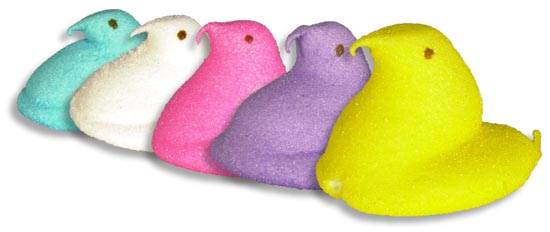In the last four weeks, Hop has split the top box office spot with the also animated, three-lettered Rio and the alliterative Fast Five, grossing 105 million dollars in the United States and over 160 million dollars worldwide. Initially, my concern over this movie revolved around the notion that Easter bunnies were able to defecate jelly beans, and while this solidifies my dislike for the assorted color turds, the desire to see whether the vermin would also micturate Yoohoo didn’t increase my intrigue in the film and hardly justified its financial success.
So, this post could be a rant on how the value of children-aimed cinema has taken a dastardly turn, relying on bodily functions to kindle laughter, desensitizing younger viewers to vulgarities and decomposing all thought-provoking and intelligent humor into a – dare I say, literal – cesspool; however, Dane Cook’s success has already proved this point, so I’ll take my tangent in a different direction:
The commercial easter’s facade obscures the rise of the oligarch and the disenfranchisement of the proletariat.
All religious aspects of Easter aside, the symbol of the commercial Easter holiday is undoubtedly a tandem of colorful eggs and various versions of chocolate bunnies and bunnies hocking cream-filled eggs for Cadbury, a company without the need to change their ad campaign for two decades, declaring “Nobunny knows Easter better than Hersheys,” which is clever enough to substitute “bunny” for “body” as a form of subliminal advertising that makies “bunny” part of our holiday vernacular that posseses a sacrosanct connotation.
In turn, this gives the mammal power over all others who try to stand-in as the spokesperson for the holiday, an arrangement that is doubly confirmed during the “Cadbury auditions,” where a pig, a cat and a lion all try nobly to wear the bunny ears, but fail miserably. As cute as the commercial is, particularly the pig wearing bunny ears, there’s an agenda to all of this that glamorizes the beautifully soft, delicate bunny and villainizes the producer of the eggs that we covet and color each April: the chicken, a worker toiling behind the scenes whilst the holiday is emceed by a non-egg-laying mammal. In the end, this propaganda glamorizes the figurehead and taints the worker, leaving him undesirable.

Don’t believe me? When was the last time you sorted through an easter basket, bypassing the various branded eggs from Reeses, Snickers, Butterfinger and the like in order to eat all of the Peeps, those crusty, slightly amorphous, marshmallow filled, mutated jelly molds?
Hop does nothing to dispel this agenda, and, instead, reinforces it by exhibiting an Easter bunny that lives with his son in a statue on Easter Island, both reaping the benefits of being the symbol of a major holiday. Evidence of this can be seen not only in a glimpse of the son’s room which is replete with toys, posters, books, and musical instruments, but also in the scepter that the Easter Bunny holds, a traditional symbol of royalty and authority. In addition, the Easter Bunny’s son is named E.B, which portends that there is also a tradition of primogeniture in the works here, where class, status, and wealth are passed from the patriarch in the family to (most often) the first born son, allowing the inheritance to flow freely from one generation to another.
However, in order for this wealth to flow, the line must be untainted, which also presumes that the Easter Bunny must maintain complete control of his affairs, and those of his son, which is suggested by the egg-shaped globe within their home. While this might seem strangely cute to some, the truth is that the Easter Bunny has fabricated knowledge for his son to attain and has limited his growth by propagating false information, even in regards to Copernican theories.
In addition to confirming the oligarchic and dictatorial grasp that the Easter Bunny has on nature, Hop also further castigates the producers of the candy that the Easter Bunny is tasked with delivering once a year in order to stay in business. However, with his supply of bunny lackeys it seems more probable that he’s outsourcing his work and taking a cut of the proceeds. Regardless, when E.B ventures out on his own, causing his father to send out a search party, the factory staff is partially depleted, and Carlos, the lead chick, stages a coup, overthrowing the Easter Bunny and taking control of the factory. But, the problem here is fabricated, and the viewer is forced to side with the Easter Bunny, labeling Carlos and his ilk as “villain.”
It is apparent that the only contact the Easter Bunny has with his employees is on the observation deck, high above them, monitoring their every move as if he were the foreman overseeing the progress in an ant farm. What’s doubly offensive is that the Easter Bunny has put no work into producing the candy – much less laying the eggs – and his position is acquired through previous acts of primogeniture that might very well have gestated through the Great Chain of Being, a belief that royalty was appointed by God, and thereby an extension of God. (Please see King James I / VI’s Basilikon Doron.)
Perhaps Hop ends with a power sharing agreement between the two, and perhaps it ends with a banishing of Carlos from the Easter Island lair, relegating him to a symbol of the dangers of uprising, training future chick generations to know their place. If it is the former, perhaps Hop II will be an installment more analogous to the political climate of Zimbabwe. If it is the latter, then the iron grasp of the dictatorship will cease to loosen and all that is solid for the Peeps will melt in the air.
In the words of Percy Bysshe Shelley, I say to the chicks and their Peep brethren, “Let a great Assembly be of the fearless and the free”! Vive le Peep!





